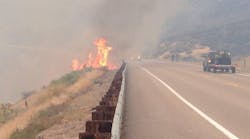Last weekend there was an enormous haze over Alberta. It was due to wildfires burning hundreds of miles away down in the Okanogan of Washington State. Earlier in the year we were under smoke from the Yukon and British Columbia. Wildfires have been prominent in the news this year with fires in Washington, California, Montana, British Columbia, record numbers in Alberta, huge fires in the Yukon and Saskatchewan. A recent report stated that there were 64 large active fires in western states and those fires had burned more than 1.9 million acres. Many hundreds of homes have been destroyed.
Over the last few years my consulting practice has been increasingly involved in power line initiated wildfires. Some recent work for the province of Alberta had me in contact with utilities serving the most widely recognized fire prone US states and Canadian provinces. The impression I’m left with after these conversations and completed questionnaires is that only a handful of utilities have fully appreciated the risk of power line initiated wildfires. Those utilities are located in California and Colorado. Wildfires are of course a concern to all the utilities contacted but what specific actions have been taken that go beyond the typical utility VM program? What resources have been dedicated to mitigating the risk of a power line caused wildfire?
Resources are the key. There won’t be additional actions or personnel dedicated to mitigating wildfire risk without funding. So this issue rises to the top of utility companies. What presents a greater risk to T & D utilities than wildfires? Maybe storm damage. Wildfires often put the lives of many people at risk. I can’t think of anything on the T & D side that holds a greater potential for property losses.
In February of 2009 bushfires in the state of Victoria, Australia resulted in the loss of 173 lives and damages were estimated at $4 billion. A 2011 wildfire in Bastrop Texas resulted in the loss of life, 1673 homes destroyed representing $325 million in insured losses. A 2011 Alberta wildfire destroyed 435 homes in Slave Lake. Insurable losses were in excess of $700 million. Additionally, it was reported that due to business disruption the oil and gas industry suffered losses of $300 million. Colorado’s 2012 Waldo Canyon fire resulted in the loss of life, 247 homes lost and $454 million in insured losses. Between the years 2000 and 2012 major wildfires in US resulted in about $7.6 billion in insurable losses. The states of Colorado, California, Montana and New Mexico have experienced the largest wildfires in recorded history in the period since 2000.
OK, so I’ve waved the red flag and you may be thinking electric lines are not a primary cause of wildfires and that is true. The primary causes are human and lightning. Power line initiated wildfires are a small percentage of the total. The difficulty is that even if power lines were responsible for only 1 in 100 wildfires we don’t know if that 1 of 100 will turn into a fire for the record books.
Precipitation, temperature, wind speed, wind direction and humidity, variables which have a significant impact on fire behavior, are beyond our control. We have fire groups which monitor these variables and inform us of the fire risk. How does your utility respond to high fire risk warnings? Yes, circulating reminders about smoking materials, spark arresters, hot mufflers, etc. is good but what else?
It needs to start at the top with a recognition that wildfires are if not the top risk, for electric utilities in fire prone areas then certainly among the top risks. Then it would follow that the resources be put in place to first develop the best understanding possible of the risk and the most effective mitigation options. For example, what if you had a policy to switch reclosers to single shot in fire prone areas on high fire risk days and to not reclose after a fault without a visual inspection of the line? What would be cost? How much is the risk of starting a wildfire reduced? I don’t have the answers but it is obvious to me that it is the utilities that are best positioned to answer such questions.
While wind may knock lines to the ground or result in phase slapping, much of the risk of power line initiated wildfires arises from tree contact with the lines, whether the tree ignites or drops embers to ground, causes contact between phases or results in an energized conductor on the ground. I’ll leave the discussion of tree risk until next month.
In case you are a utility executive thinking thank goodness we don’t operate in a fire prone state, I’m not done waving the red flag. Would you think of Tennessee as a fire prone state? I wouldn’t. Yet in 2014 Tennessee had 1,249 wildfires that burned over 150,000 acres. Have a look at the 2104 Wildfires by State to see if your state is truly a low wildfire risk state.


